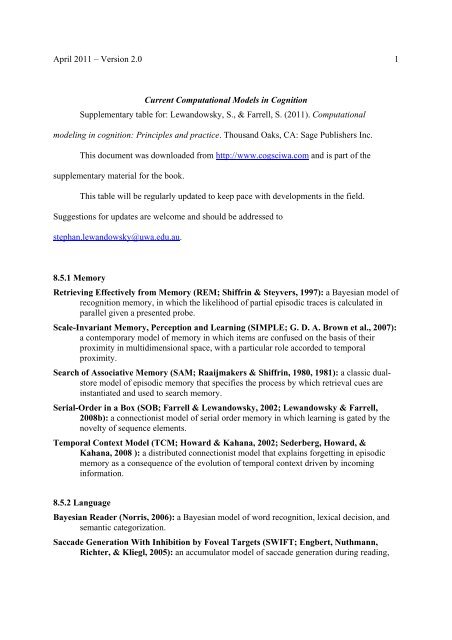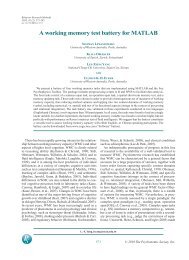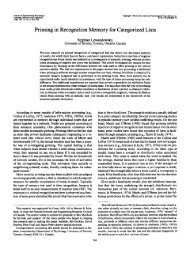TableFromCh8_Refs_checked.pdf
TableFromCh8_Refs_checked.pdf
TableFromCh8_Refs_checked.pdf
Create successful ePaper yourself
Turn your PDF publications into a flip-book with our unique Google optimized e-Paper software.
April 2011 – Version 2.0 1<br />
Current Computational Models in Cognition<br />
Supplementary table for: Lewandowsky, S., & Farrell, S. (2011). Computational<br />
modeling in cognition: Principles and practice. Thousand Oaks, CA: Sage Publishers Inc.<br />
This document was downloaded from http://www.cogsciwa.com and is part of the<br />
supplementary material for the book.<br />
This table will be regularly updated to keep pace with developments in the field.<br />
Suggestions for updates are welcome and should be addressed to<br />
stephan.lewandowsky@uwa.edu.au.<br />
8.5.1 Memory<br />
Retrieving Effectively from Memory (REM; Shiffrin & Steyvers, 1997): a Bayesian model of<br />
recognition memory, in which the likelihood of partial episodic traces is calculated in<br />
parallel given a presented probe.<br />
Scale-Invariant Memory, Perception and Learning (SIMPLE; G. D. A. Brown et al., 2007):<br />
a contemporary model of memory in which items are confused on the basis of their<br />
proximity in multidimensional space, with a particular role accorded to temporal<br />
proximity.<br />
Search of Associative Memory (SAM; Raaijmakers & Shiffrin, 1980, 1981): a classic dualstore<br />
model of episodic memory that specifies the process by which retrieval cues are<br />
instantiated and used to search memory.<br />
Serial-Order in a Box (SOB; Farrell & Lewandowsky, 2002; Lewandowsky & Farrell,<br />
2008b): a connectionist model of serial order memory in which learning is gated by the<br />
novelty of sequence elements.<br />
Temporal Context Model (TCM; Howard & Kahana, 2002; Sederberg, Howard, &<br />
Kahana, 2008 ): a distributed connectionist model that explains forgetting in episodic<br />
memory as a consequence of the evolution of temporal context driven by incoming<br />
information.<br />
8.5.2 Language<br />
Bayesian Reader (Norris, 2006): a Bayesian model of word recognition, lexical decision, and<br />
semantic categorization.<br />
Saccade Generation With Inhibition by Foveal Targets (SWIFT; Engbert, Nuthmann,<br />
Richter, & Kliegl, 2005): an accumulator model of saccade generation during reading,
April 2011 – Version 2.0 2<br />
accounting for effects of word length and word frequency on fixation positions and<br />
latencies.<br />
Dual-Route Cascade Model of Reading (DRC; Coltheart, Rastle, Perry, Langdon, &<br />
Ziegler, 2001): a connectionist model of word recognition and naming that assumes<br />
different methods of processing words (variously using semantic, lexical, and graphemic<br />
knowledge) are carried out in parallel.<br />
Bound Encoding of the Aggregate Language Environment (BEAGLE; M. N. Jones &<br />
Mewhort, 2007): a composite holographic model that builds representations of word<br />
meaning and word order from unsupervised experience with natural language.<br />
Word-form Encoding by Activation and VERification (WEAVER; Roelofs, 1997): a model<br />
explaining how the passing of activation between localist representations of lexical,<br />
syntactic, and morphemic information enacts retrieval of word forms in speech<br />
production.<br />
8.5.3 Perception and Action<br />
Model of the Influence of Task on Attention (Navalpakkam & Itti, 2005): the model explains<br />
task-specific guidance of visual attention in real-world scenes. Information about the task<br />
is stored in working memory and, together with relevant long-term information, biases<br />
the visual attention system to perceive relevant features.<br />
Recurrent Model of Sequential Action (Botvinick & Plaut, 2004): a recurrent connectionist<br />
model of sequential action that explains context as recurrent feedback from previous<br />
network states.<br />
Dynamical Systems Model of Coordination (Haken, Kelso, & Bunz, 1985): a dynamical<br />
systems model treating bimanual coordination as a system of coupled oscillators, where<br />
qualitative changes in coordinating behaviour arise from phase transitions.<br />
The Bayesian Ventriloquist (Alais & Burr, 2004): a Bayesian model of multimodal integration<br />
that explains ventriloquism as precise (in terms of spatial location) visual information<br />
capturing imprecise auditory information.<br />
Neural Model of Cognitive Control (J.W. Brown, Reynolds, & Braver, 2007): a neurally<br />
inspired model that implements two distinct control mechanisms for task switching.<br />
8.5.4.a Perceptual Decision Making<br />
Diffusion Model (Ratcliff & Rouder, 1998): a diffusion model of two-choice decisions, in<br />
which evidence drives a random walk between two decision thresholds until one of the<br />
thresholds is crossed.<br />
Leaky Integrator Model (Usher &McClelland, 2001): an accumulator model of decision<br />
making, in which the activity of accumulators increases stochastically over time but is
April 2011 – Version 2.0 3<br />
limited by leakage from the accumulators and competition (inhibition) between<br />
accumulators.<br />
(Linear) Ballistic Accumulator Model (LBA; S. Brown & Heathcote, 2005; S. D. Brown &<br />
Heathcote, 2008): a simple, deterministic accumulator model in which latency variability<br />
arises from variability in model parameters across trials; different versions do or do not<br />
assume inhibition between accumulators.<br />
8.5.4.b Judgment and Choice, models of Economic Behavior<br />
Prospect Theory (Kahneman & Tversky; e.g., 1979): probably the most influential descriptive<br />
model in psychology which earned Kahneman a Nobel Prize. It accounts for many basic<br />
aspects of decision making, such as people’s tendency to underweight probable outcomes<br />
over those that are certain.<br />
Regret theory (Loomes & Sugden, 1982): an alternative to Prospect Theory that is arguably<br />
simpler and accounts for much of the same data.<br />
Decision Field Theory (DFT; Busemeyer & Townsend, 1993): a model of decision making<br />
under uncertainty, in which a random walk is driven by samples from possible events and<br />
the valence of the outcomes.<br />
Decision by sampling (BbS; Stewart, Chater, & Brown, 2006): a model of decision making<br />
especially in economic contexts that is based on the notion that people sample a few<br />
relevant instances from memory and judge an attribute based on its rank within that<br />
sample.<br />
8.5.5 Identification and Categorization<br />
Generalized Context Model (GCM; Nosofsky, 1986): an exemplar model of categorization, in<br />
which objects in the world are categorized according to their aggregate perceptual match<br />
to experienced objects in memory.<br />
Attention Learning and Covering Map (ALCOVE; Kruschke, 1992): a connectionist<br />
instantiation of the GCM that implements learning of attention and exemplar-to-category<br />
associations.<br />
General Recognition Theory (GRT; Ashby, 1992b): a model of categorization in which the<br />
multidimensional space in which items are represented is carved up by decision<br />
boundaries, and objects are categorized according to the partition in which they fall.<br />
Supervised and Unsupervised STratified Adaptive Incremental Network (SUSTAIN; Love,<br />
Medin, & Gureckis, 2004): an exemplar model in which a new exemplar is stored only<br />
if it is sufficiently novel or surprising and explains both supervised and unsupervised<br />
learning.
April 2011 – Version 2.0 4<br />
Selective Attention, Mapping, and Ballistic Accumulation (SAMBA; S. D. Brown, Marley,<br />
Donkin, & Heathcote, 2008): a model of absolute identification in which perceptual<br />
information is accumulated over time, based on comparisons between the stimulus and<br />
anchor points set by the participant.<br />
Relative Judgment Model (RJM; Stewart, Brown, & Chater, 2005): a model of absolute<br />
identification in which identification is based on comparisons between the current and<br />
previous stimuli, as well as feedback from the previous trial.
April 2011 – Version 2.0 5<br />
References<br />
Alais, D., & Burr, D. (2004). The ventriloquist effect results from near-optimal bimodal<br />
integration. Current Biology, 14, 257–262.<br />
Ashby, F. G. (1992b). Multidimensional models of perception and cognition. Hillsdale, NJ:<br />
Erlbaum.<br />
Botvinick, M. M., & Plaut, D. C. (2004). Doing without schema hierarchies: A recurrent<br />
connectionist approach to normal and impaired routine sequential action. Psychological<br />
Review, 111, 395–429.<br />
Brown, G. D. A., Neath, I., & Chater, N. (2007). A temporal ratio model of memory.<br />
Psychological Review, 114, 539–576.<br />
Brown, J. W., Reynolds, J. R., & Braver, T. S. (2007). A computational model of fractionated<br />
conflict-control mechanisms in task-switching. Cognitive Psychology, 55, 37–85.<br />
Brown, S., & Heathcote, A. (2005). A ballistic model of choice response time. Psychological<br />
Review, 112, 117–128.<br />
Brown, S. D., & Heathcote, A. (2008). The simplest complete model of choice response time:<br />
Linear ballistic accumulation. Cognitive Psychology, 57, 153–178.<br />
Brown, S. D.,Marley, A. A. J., Donkin, C., & Heathcote, A. (2008). An integrated model of<br />
choices and response times in absolute identification. Psychological Review, 115, 396–<br />
425.<br />
Busemeyer, J. R., & Townsend, J. T. (1993). Decision field theory: A dynamic cognitive<br />
approach to decision making in an uncertain environment. Psychological Review, 100,<br />
432–459.<br />
Coltheart, M., Rastle, K., Perry, C., Langdon, R., & Ziegler, J. (2001). DRC: A dual route<br />
cascade model of visual word recognition and reading aloud. Psychological Review, 108,<br />
204–256.<br />
Engbert, R., Nuthmann, A., Richter, E. M., & Kliegl, R. (2005). SWIFT: A dynamical model of<br />
saccade generation during reading. Psychological Review, 112, 777–813.<br />
Farrell, S., & Lewandowsky, S. (2002). An endogenous distributed model of ordering in serial<br />
recall. Psychonomic Bulletin & Review, 9, 59–79.<br />
Haken, H., Kelso, J. A. S., & Bunz, H. (1985). A theoretical model of phase transitions in human<br />
hand movements. Biological Cybernetics, 51, 347–356.<br />
Howard,M.W., & Kahana, M. J. (2002). A distributed representation of temporal context.<br />
Journal of Mathematical Psychology, 46, 269–299.<br />
Jones, M. N., & Mewhort, D. J. K. (2007). Representing word meaning and order information in<br />
a composite holographic lexicon. Psychological Review, 114, 1–37.<br />
Kahneman, D. & Tversky, A. (1979). Prospect theory: An analysis of decision under risk.<br />
Econometrica, 47, 263-291.
April 2011 – Version 2.0 6<br />
Kruschke, J. K. (1992). ALCOVE: An exemplar-based connectionist model of category learning.<br />
Psychological Review, 99, 22–44.<br />
Lewandowsky, S., & Farrell, S. (2008b). Short-term memory: New data and a model. In B. H.<br />
Ross (Ed.), The psychology of learning and motivation (Vol. 49, pp. 1–48). London, UK:<br />
Elsevier.<br />
Loomes, G. & Sugden, R. (1982). Regret theory: An alternative theory of rational choice under<br />
uncertainty. The Economic Journal, 92, 805-824.<br />
Love, B. C., Medin, D. L., & Gureckis, T. M. (2004). SUSTAIN: A network model of category<br />
learning. Psychological Review, 111, 309–332.<br />
Navalpakkam, V., & Itti, L. (2005). Modeling the influence of task on attention. Vision<br />
Research, 45, 205–231.<br />
Norris, D. (2006). The Bayesian reader: Explaining word recognition as an optimal Bayesian<br />
decision process. Psychological Review, 113, 327–357.<br />
Nosofsky, R. M. (1986). Attention, similarity, and the identification-categorization relationship.<br />
Journal of Experimental Psychology: Learning, Memory, and Cognition, 115, 39–61.<br />
Raaijmakers, J. G. W., & Shiffrin, R. M. (1980). SAM: A theory of probabilistic search of<br />
associative memory. In G. H. Bower (Ed.), The psychology of learning and motivation<br />
(Vol. 14, pp. 207–262). New York: Academic Press.<br />
Raaijmakers, J. G. W., & Shiffrin, R. M. (1981). Search of associative memory. Psychological<br />
Review, 88, 93–134.<br />
Ratcliff, R., & Rouder, J. N. (1998). Modeling repsonse times for two-choice decisions.<br />
Psychological Science, 9, 347–356.<br />
Roelofs, A. (1997). The WEAVER model of word-form encoding in speech production.<br />
Cognition, 64, 249–284.<br />
Sederberg, P. B., Howard, M. W., & Kahana, M. J. (2008). A context-based theory of recency<br />
and contiguity in free recall. Psychological Review, 115, 893–912.<br />
Shiffrin, R. M., & Steyvers,M. (1997). A model for recognition memory: REM— retrieving<br />
effectively from memory. Psychonomic Bulletin & Review, 4, 145–166.<br />
Stewart, N., Brown, G. D. A., & Chater, N. (2005). Absolute identification by relative<br />
judgement. Psychological Review, 112, 881–911.<br />
Stewart, N.; Chater, N. & Brown, G. D. A. (2006). Decision by sampling. Cognitive Psychology,<br />
53, 1-26.<br />
Usher, M., & McClelland, J. L. (2001). The time course of perceptual choice: The leaky,<br />
competing accumulator model. Psychological Review, 108, 550–592.





